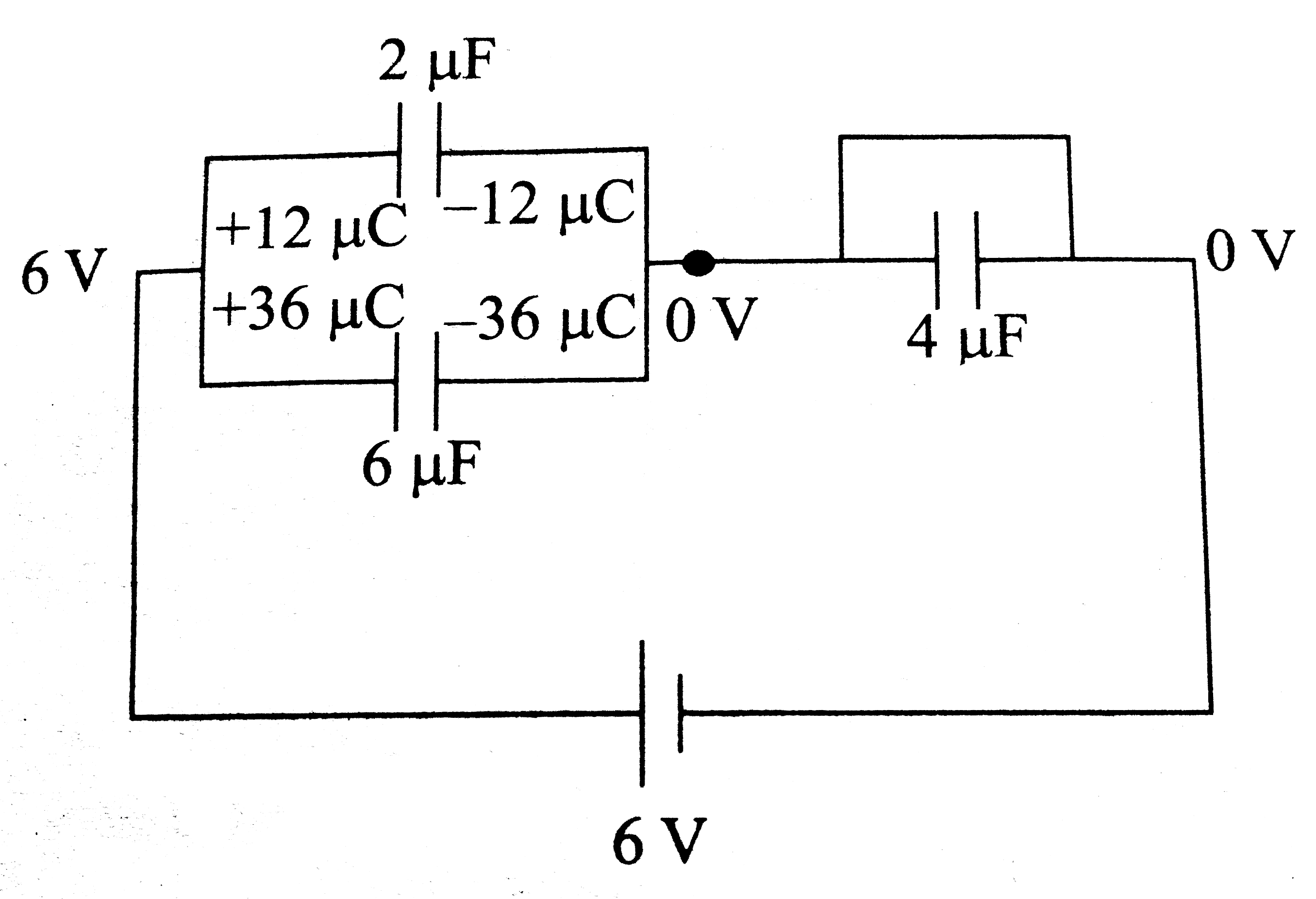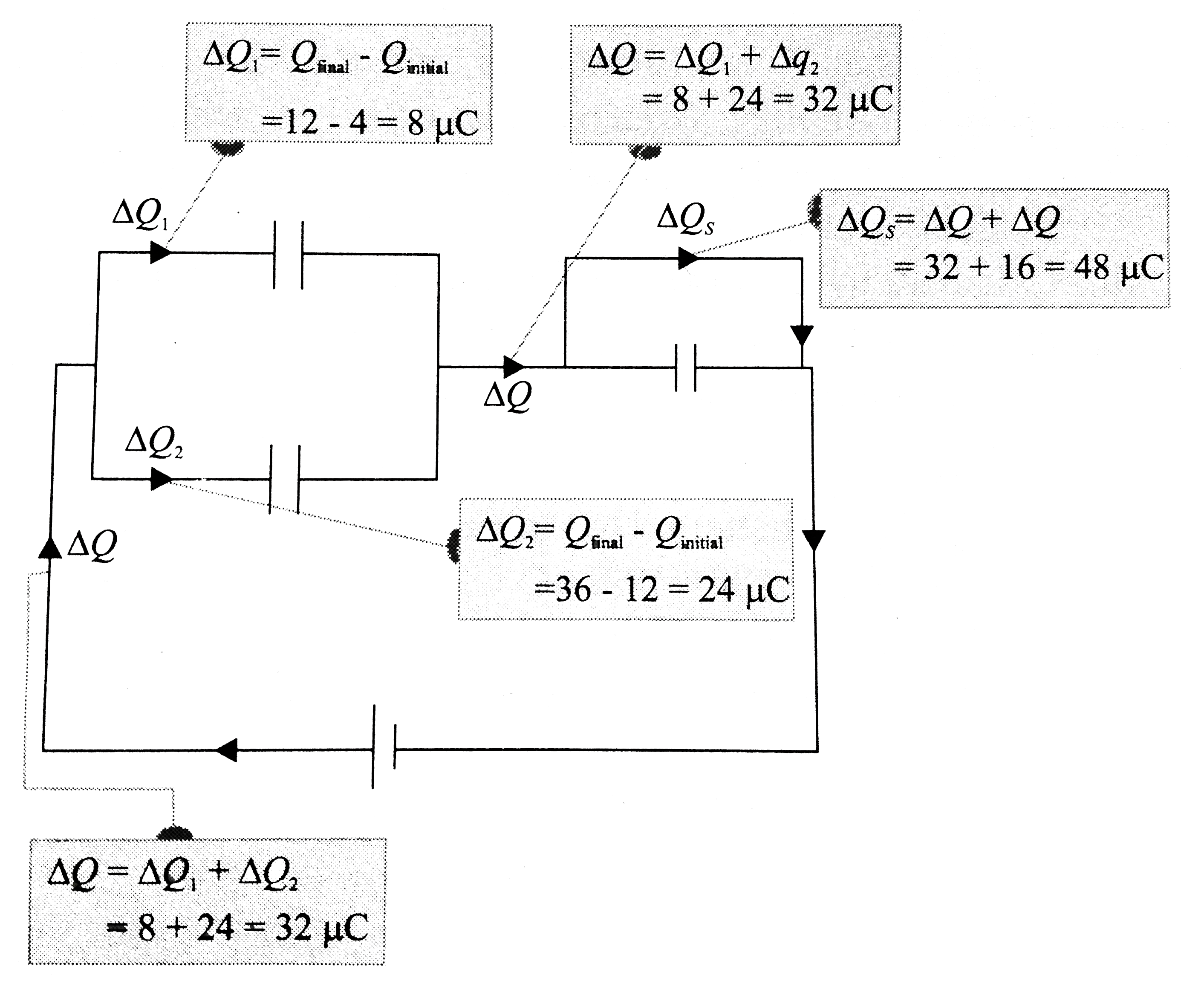In, all the capacitors are in steady state initially.
i. What is the charge flowing through the switch when it is closed?
ii. What is the charge flowing section AB?
iii. What is the work done by the battery?
iv. What is the heat produced when (S) is closed?
 .
.
Before closing the switch,
4x+(x−6)2+(x−6)2=0 or x=4V
∣∣Q4μF∣∣=16μC,∣∣Q2μF∣∣=4μC
∣∣Q6μF∣∣=12μC
When switch Sw is closed, the 4μF capacuit is short-circuited, and the potential difference across it becomes zero. The circuit after closing the switch is shown in

 .
.
 .
.
shown the charges coming and going out of the capacitors. So the charge through section AB is 32μC, and the charge through the switch is 48μC. When the switch is closed, 16μC charge from the left plate goes the switch is charge passing through th battery is 32μC. so the work done by the battery is
Wbattery=ΔqV=(32μC)(6V)=192μJ
Heat produced is
H=Wbattery−ΔU=Wbattery−(UfUi)
Uf=12(2)×62+12(6)(6)2=144μJ
and Ui=124(4)2+12(8)22=48μJ
H=[192−(144−48)]μJ=96μJ.
Topper's Solved these Questions
- CAPACITOR AND CAPACITANCEBOOK - CENGAGE PHYSICSCHAPTER - CAPACITOR AND CAPACITANCEEXERCISE - Exercise 4.1
13 Videos
- CAPACITOR AND CAPACITANCEBOOK - CENGAGE PHYSICSCHAPTER - CAPACITOR AND CAPACITANCEEXERCISE - Exercise 4.2
32 Videos
- CAPACITOR AND CAPACITANCEBOOK - CENGAGE PHYSICSCHAPTER - CAPACITOR AND CAPACITANCEEXERCISE - Integer
5 Videos
- ATOMSBOOK - CENGAGE PHYSICSCHAPTER - ATOMSEXERCISE - QUESTION BANK
40 Videos
- CENGAGE PHYSICS DPPBOOK - CENGAGE PHYSICSCHAPTER - CENGAGE PHYSICS DPPEXERCISE - subjective type
51 Videos
Similar Questions
The flow of charge through switch S if it is closed is

View SolutionConsider the situation shown in the figure. The switch S is open for a long time and then closed and again steady state reached then

(a) Find the charge flown through the battery after the switch S is closed.
(b) Find the charge flown through the switch S from B to A.
(c) Find the work done by the battery after the switch S is closed.
(d) Find the change in energy stored in the system of capacitors.
(e) Find the heat developed in the system after the switch S is closed.
View Solution
Knowledge Check
The flow of charge through switch S if it is closed is
 AzeroBq4C2q3Dq3
AzeroBq4C2q3Dq3In the circuit shown, find the amount of charge that will flow through the key when it is closed.
 A20μCB40μCC80μCD120μC
A20μCB40μCC80μCD120μCIn fig. A2.27, the charge that flows from P to Q when the switch S is closed is
 A3μCB6μCC9μCD15μC
A3μCB6μCC9μCD15μC
Consider the situation shown in the figure. The switch S is open for a long time and then closed and again steady state reached then

(a) Find the charge flown through the battery after the switch S is closed.
(b) Find the charge flown through the switch S from B to A.
(c) Find the work done by the battery after the switch S is closed.
(d) Find the change in energy stored in the system of capacitors.
(e) Find the heat developed in the system after the switch S is closed.
View SolutionFour uncharged capacitors are charged by 24V battery as shown in the figure. How much charge flows through switch S when it is closed?

View SolutionFind the charge which flows from point A to B, when switch is closed

View SolutionIn fig. A2.27, the charge that flows from P to Q when the switch S is closed is

View SolutionIn fig , after closing switch S, what is the change in curent flowing through A? the battery is ideal.

View Solution
